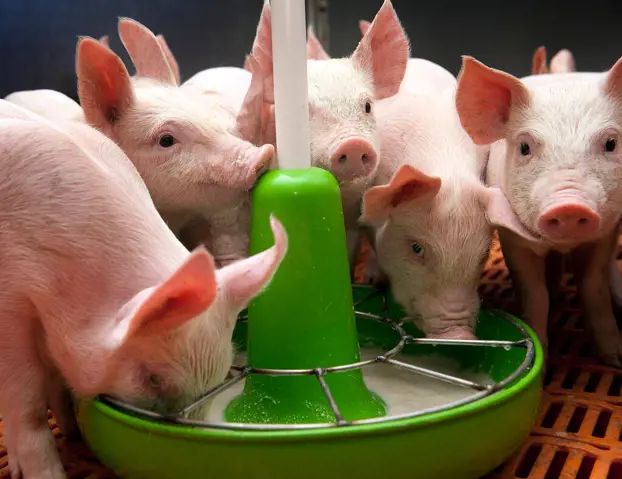 Piglets
Piglets
Managing piglets healthy throughout their first weeks before and after weaning is the foundation for high returns of any pig farmer. Our expertise bring solutions that focus on design and production of highly nutritional piglet feeds.
Best feed solution combined with optimal support

Creep feeds
Our creep feeds stimulate the intestinal development of the piglets through the usage of carefully selected raw materials and the treatment of these raw materials. With these feeds we are creating a good start in the most crucial time of a piglets life.

Challenges we can help you with
FREQUENTLY ASKED QUESTIONS
We have the answers to your question
The weaning weight of piglets can be increased via an increased sow milk production and increased intake of creep feed. The milk production of sows can be increased by adjusting the feeding schedule of the sows during the lactation period. Next to that the diet composition of the lactation can be adjusted, as for a higher milk production more nutrients are required. Koudijs has knowledge on what nutrients shoud be adjusted to achieve an increased milk production of the sows. It is important to keep track of the development of body condition of sows as if milk production increases often this results in an increased loss of body condition. Therefore it is important to 'repair' this body condition loss during the following gestation period, to prepare the sows for a good milk production in the next farrowing. Even though nutrient intake of piglets via creep feed is limited compared to sow's milk, but it still contributes in increasing the weaning weight of piglets.
Koudijs has specialised creep diets which can be fed supplementary to sow's milk. Important in those diets is the choice of raw materials as young piglet's can't digest all raw materials as well as olders pigs can. Koudijs has many management recommendations to maximize the feed intake of those creep feed diets in the farrowing room.
The main reason for diarrhea post-weaning is an E. Coli infection. E. Coli is a natural inhabitant of the intestine, however can result in diarrhea as soon as intestinal health is disturbed. The two main reasons for a reduced intestinal health are a too low feed intake as well as a too high feed intake post-weaning. A too low feed intake results in damage to the villi and crypts in the intestine due to insufficient energy supply for maintenance. Due to the damage less enzymes are produced for the digestion of raw materials and absorption surface is reduced. This results in increased undigested nutrients entering the large intestine and especially udigested protein is a risk as it is used as medium to growth on for E. Coli. Finally this results in a quick multiplication of E. Coli, damaging the large intestine and therefore resorption of water is reduced which results in diarrhea. A too high feed intake is a risk as well as the not all nutrients will be digested and absorpted again resulting in substrate in the large intestine for quick multiplication of E. Coli.
Part of the solution is feeding a creep feed next to sow's milk in the farrowing room as it trains piglets to digest cereals and vegetable proteins, therefore increasing digestive capacity post-weaning. Next to that a higher creep feed intake in the farrowing room also stimulates the feed intake post-weaning which reduces the risk for a too low feed intake post-weaning. Also important is to select the correct diets post-weaning which should be done based on the feed intake, as if feed intake is low a diet should be selected which stimulates feed intake while if feed intake is too high the diet should earlier reduce feed intake.
Koudijs has knowledge on what raw materials stimulate or reduce feed intake and this is implemented in the concepts. Last but not least also concepts to stimulate intestinal health (e.g. probiotics, prebiotics and specific fibers) and reduce pathogenic pressure (e.g. selection of organic acids) can support in reducing diarrhea in piglets post-weaning.
Even though litters are sometimes small it is still beneficial to feed a creep feed. Next to the supply of nutrients for an increased weight gain it also has other benefits. It learns piglets to drink water, as creep feed intake stimulates water intake. If not supplying a creep diet piglets might rely on the water in milk and therefore not know how a water nipple works. This could lead after weaning to a delay in water intake post-weaning which will be negative on the feed intake post-weaning. It also learns piglets to eat dry feed, as the are used to just drink milk. Also does it learn piglets to digest as there are components in dry feed (starch and vegetable protein) which are not in sow's milk. Enzymes are required to digest them and by supplying it in the farrowing room piglets start to produce those enzymes which prepares the piglets for digesting greater quantities of startch and vegetable protein post-weaning.
The main reason for developing of ear necrosis is a shortage in supply of oxygen to the hair vessels in the ears. The main reasons for this are blocked ear veins, reduced blood flow and external damage. Koudijs developed knowledge in what ways those reasons develop. All of these reasons do have their own nutritional and management solutions. As an example too less ventilation of the room can result in a reduced oxygen level of the air, increasing the risk for ear necrosis. If reduced blood flow is on a farm the cause for ear necrosis, addition of fish oil, might be a solution as it widens the blood vessels. For more pathways and solutions, contact your Koudijs sale representative.
